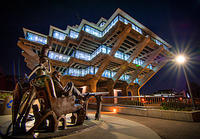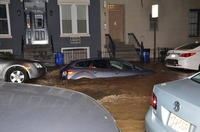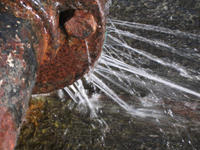-
Mother Nature offers best protection for coastal communities’ infrastructure
Extreme weather, sea-level rise, and degraded coastal ecosystems are placing people and property at greater risk of damage from coastal hazards. The likelihood and magnitude of losses can be reduced by intact ecosystems near vulnerable coastal communities. Scientists say that natural habitats such as dunes and reefs are critical to protecting millions of U.S. residents and billions of dollars in property from coastal storms.
-
-
Using crowdsourcing for earthquake monitoring
The U.S. Geological Survey (USGS) and other scientific institutions are using social media and crowdsourcing to learn more about earthquakes, according to a new report. These techniques provide inexpensive and rapid data to augment and extend the capabilities provided by traditional monitoring techniques.
-
-
U.S. ports vulnerable to cyberattacks
New study says that the U.S. largest ports are vulnerable to cyberattacks.The study argues that the level of cyber security awareness and culture in U.S. port facilities is relatively low, and that a cyberattack at a major U.S. port would quickly cause significant damage to the economy.
-
-
Improving the reliability, resiliency of post-Sandy N.J. electric grid
According to NOAA, prolonged electrical outages, largely because of storms, have been steadily increasing in frequency since 1995. Sandia Lab will help East Coast communities devastated by Hurricane Sandy boost the resiliency of their electric grids, so they can be better prepared to deal with natural disasters in the future.
-
-
Research network to search for extraterrestrial intelligence launched in U.K.
A network has been launched to promote academic research in the United Kingdom relating to the search for extraterrestrial intelligence. The network brings together academics from eleven institutions across the country, and it covers a broad spectrum of research topics, including potential methods for detecting signals, the linguistic challenge of deciphering messages, the probability of an extraterrestrial civilization interacting with Earth, and the longevity of civilizations.
-
-
Earthquake-proofing precast buildings
Precast or ready-made building structures offer a number of advantages when compared to more traditional construction techniques in terms of time and cost savings. The vulnerability of joints and connections between assembled precast elements, however, is widely recognized as a potential safety issue, especially in earthquake-prone areas. An EU-funded project has set out to develop new procedures and guidelines for designing precast structure joints and connections that can stand up to seismic forces.
-
-
Cuomo: New York infrastructure must be made more resilient in face of climate challenge
New York governor Andrew Cuomo says global warming l is a serious threat and that all levels of government must work together to design a more resilient infrastructure to deal with the changing weather.
-
-
Former Pentagon No. 2 suspected of being source of Stuxnet leaks
The Justice Department has informed Gen. (Ret.) James E. “Hoss” Cartwright that he is the target of an investigation into the leaking of a secret U.S.-Israeli cyber campaign to slow down Iran nuclear weapons program. The four-star Marine Corps general served as deputy chairman of the Joint Chiefs of Staff and was part of President Obama’s inner circle on many important national security issues before retiring in 2011.
-
-
Maryland shorelines facing sea level rise threatening state’s infrastructure: report
Maryland has 3,100 miles of tidal shoreline and low-lying rural and urban lands that will be impacted. A new report on sea level rise recommends that the State of Maryland should plan for a rise in sea level of as much as two feet by 2050. Governor Martin O’Malley said that “[we must] ensure that we have a sound understanding of our vulnerability and are making informed decisions about how best to protect our land, infrastructure, and most importantly, the citizens of Maryland.”
-
-
Planned Calif. building demolition to provide information about nearby fault
When California State University, East Bay (CSUEB) demolishes its seismically unsafe Warren Hall this summer on its Hayward campus, the landmark building’s implosion will produce energy similar to a small earthquake which can be used to study and map the nearby Hayward Fault. In cooperation with the university, the U.S. Geological Survey will observe and record the mid-August implosion on hundreds of seismographs temporarily set out in a roughly one-mile radius from Warren Hall.
-
-
Registration opens for NIST Cybersecurity Framework Workshop

Executive Order 13636, Improving Critical Infrastructure Cybersecurity, gave NIST the responsibility to work with industry to develop a voluntary “framework” — incorporating existing standards, guidelines, and best practices — that institutions could use to reduce the risk of cyber attacks. The National Institute of Standards and Technology (NIST) has opened registration for its Third Cybersecurity Framework Workshop, to be held 10-12 July 2013, in San Diego, California.
-
-
NASA seeks ideas on locating and exploring asteroids – and redirecting them away from Earth

NASA also released a request for information (RFI) that invites industry and potential partners to offer ideas on accomplishing NASA’s goal to locate, redirect, and explore an asteroid, as well as find and plan for asteroid threats. The RFI is part of a broader NASA program focusing on finding all asteroid threats to human populations and knowing what to do about them.
-
-
Testing the seismic strength of light frame steel construction
A partnership of leading earthquake engineering researchers from top U.S. and Canadian universities and design professionals from the steel industry have begun the final phase of a three-year project to increase the seismic safety of buildings that use lightweight cold-formed steel for their primary beams and columns. Research to conclude with shake-table testing.
-
-
Newark to raise water rates to pay for infrastructure

A report presented to Newark’s city council said that the town’s water and sewer rates will be increased by more than 60 percent over the next ten years in order to pay for $500 million in infrastructure repairs to the town’s faulty and outdated meters, century-old, leaky pipes, and broken valves.
-
-
New Jersey faces costly water infrastructure upgrades

Before Hurricane Sandy hit New Jersey, state officials knew they had much work ahead of them to update the state’s water infrastructure. The damage Sandy inflicted only highlighted the inadequacies of New Jersey’s outdated wastewater, stormwater, and drinking water infrastructure. Upgrading the system will be costly, but not doing so will be costlier.
-
More headlines
The long view
Falling Space Debris: How High Is the Risk I'll Get Hit?
An International Space Station battery fell back to Earth and, luckily, splashed down harmlessly in the Atlantic. Should we have worried? Space debris reenters our atmosphere every week.
Using Drone Swarms to Fight Forest Fires
Forest fires are becoming increasingly catastrophic across the world, accelerated by climate change. Researchers are using multiple swarms of drones to tackle natural disasters like forest fires.
